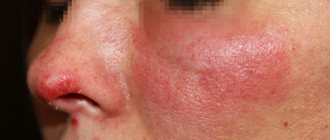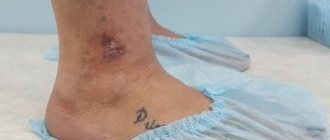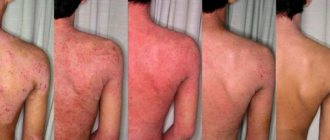- Gallery
- Reviews
- Articles
- Licenses
- Vacancies
- Insurance partners
- Partners
- Controlling organizations
- Schedule for receiving citizens for personal requests
- Online consultation with a doctor
- Documentation
Herpesvirus infections are a group of diseases caused by viruses of the Herpesviride family, which are characterized by a wide epidemic spread and a variety of clinical manifestations.
Eight types of viruses cause disease in humans:
- herpes simplex virus types 1 and 2;
- Varicella Zoster virus (VZV or herpes type 3);
- Epstein Barr virus (EBV, herpes type 4);
- cytomegalovirus (CMV, herpes type 5);
- human herpes viruses types 6, 7 and 8.
Antibodies to herpes viruses are found in 70-90% of adults.
The main risk groups for herpesvirus infections are children:
- born from mothers with a burdened obstetric history and a pathological course of pregnancy;
- recipients of blood transfusions, organs and tissues;
- children with immunodeficiency conditions.
Herpes simplex infection is characterized by a long latent course with periods of exacerbation, accompanied by blistering rashes on the skin and mucous membranes, as well as damage to the central nervous system, eyes, and internal organs.
Herpes type 1 is a disease that affects the skin of the face, mucous membranes of the mouth, and lips.
Herpes type 2 is genital herpes.
General information
The organs of the lymphatic system play a protective role in the human body. They serve as a barrier to viruses, bacteria, and also filter out harmful substances. In total, there are more than 450 lymph nodes in the adult body, and their maximum number is formed by the age of 10.
Lymph nodes are connected by lymphatic vessels - lymph (a fluid with a high content of lymphocytes, or “white blood cells”) circulates through them. Produced in the bone marrow, lymphocytes circulate throughout the body, first passing through the spleen and then the lymph nodes. Thanks to this, they gain the ability to produce antibodies to destroy microbes. Source: A.G. Rumyantsev, professor, V.M. Chernov, professor, V.M. Delyagin, professor Enlarged lymph node syndrome as a pediatric problem Practical Medicine, 2007, No. 5 (24), pp. 12-15
When an infection enters , a kind of “attack” is carried out on it, as a result of which the lymph nodes can enlarge (during this period they more actively produce antibodies). After recovery, the nodes return to normal size. If their diameter and density do not return to their original state, the child must be shown to a doctor.
Treatment of chickenpox in children
Even with a mild course of the disease, a pediatrician should monitor the child’s condition and prescribe medications. Therefore, a doctor should be called to your home at the first suspicion of chickenpox. A set of measures for this disease usually includes the following.
- A sick baby is isolated so that he does not infect others, since there are some groups of people (pregnant women, elderly people and people with chronic diseases) for whom chickenpox can be extremely dangerous.
- Strict bed rest is prescribed for severe cases of the disease or limit physical activity if the disease is mild.
- When treating chickenpox, if no complications are observed, do not use antiviral drugs and antibiotics.
- The child should be offered to drink a lot: clean water, tea, fruit drinks.
- The diet should be as light as possible: soups, steamed fish and meat, pureed fruits and vegetables (if there is a rash on the oral mucosa).
- Suitable drugs based on ibuprofen and paracetamol are used as antipyretics.
- To treat the rash, antiseptics are used: fucorcin, brilliant green, hydrogen peroxide, potassium permanganate, zinc-based products.
- If the itching is severe, your doctor may prescribe antihistamines.
- If a rash forms in the mouth, the pediatrician will recommend rinsing with furatsilin and herbal decoctions. Painful wounds can be lubricated with anesthetic gels.
- If there are scars left after chickenpox, they are lubricated with special products prescribed by the doctor.
Indicators of normal lymph nodes:
- diameter up to approximately 5 mm;
- soft consistency;
- single location, that is, lack of connection with each other or with the skin;
- absence of pain upon palpation (palpation);
- mobility.
Reasons for enlargement and main groups of lymph nodes
| Group of lymph nodes | Typical reasons for the increase |
| Parotid | Pyoderma (inflammation of the scalp accompanied by pus), inflammation of the outer or middle ear, the presence of lice, atopic dermatitis, eczema. |
| Occipital | Various inflammations in the scalp, fungal diseases, rubella, etc. |
| Submental | Abscess of the jaw, inflammation of the lower lip, damage to the front teeth, stomatitis. |
| Submandibular | Gingivitis, stomatitis, dental damage. |
| Cervical (in the direction of the muscles at the back of the neck) | Sore throat, chronic tonsillitis, tuberculosis of the tonsils, adenoids, infectious form of mononucleosis. |
| Cervical (middle) | Scarlet fever, tonsillitis, “cat scratch disease”, Hodgkin or non-Hodgkin lymphoma ( important - these are malignant oncological processes!), toxoplasmosis. |
| Cervical (lateral) | Tumors, lymph node tuberculosis, nasopharyngeal infections. |
| Elbow | Infections of the forearm or hand. |
| Axillary | Shoulder or arm infections, vaccine reactions, cat scratch disease. |
| Inguinal | Infections of the skin, bones and muscles of the lower extremities, inflammation of the joints, dermatitis, inflammatory processes in the genitals, reaction to a vaccine introduced into the femoral area. |
Features of the disease
The main characteristic symptom of chickenpox is the appearance of a finely blistered rash throughout the body, in the mouth, and on the genital mucosa. It resembles blisters containing fluid. The rash appears within a few days. At first, a speck is visible, then it turns into a vesicle, which bursts after a few hours, forming a crust. Each element of the rash undergoes changes within 5 days, so different elements of the rash are located on the body at the same time.
In mild cases of chickenpox, inflammation of the lymph nodes is not observed.
If the rash becomes infected when scratched, pustules appear, and lymphocytes block the development of pyogenic bacteria, preventing them from entering the blood. The temperature rises, the lymph nodes become enlarged and inflamed. Especially those located near the affected tissues, for example, behind the ears or in the back of the head.
To the touch, the lymph node is dense, elastic, and sometimes painful. The increase occurs gradually, the process subsides when the last rashes on the skin disappear. This period may last for several weeks. Most often, with chickenpox, the cervical, occipital, submandibular, and subclavian lymph nodes become enlarged.
Oncological alertness
Lymph nodes are often enlarged due to lymphogranulomatosis (Hodgkin's lymphoma) or lymphosarcoma (non-Hodgkin's lymphoma). These are malignant processes that are manifested by increased density, painlessness and large diameter of the lymph nodes in the absence of other reasons for their deformation. Lymph nodes enlarge in groups, asymmetrically (for example, on one side of the neck). At the initial stage of the process, their mobility and separate arrangement are maintained. If the oncological process continues without treatment, the lymph nodes may become fused, and moderate pain rarely occurs. Source: N.V. Nagornaya, E.V. Vilchevskaya, A.P. Luachak, E.N. Marchenko, E.V. Bordyugova, A.P. Koval Hodgkin's disease (lymphogranulomatosis) in children // Child's Health, 2013, No. 1 (44), pp. 13-15
Symptoms that require consultation with a doctor are enlarged lymph nodes:
- more than 7 days;
- more than 1 group;
- accompanied by elevated body temperature;
- in a child under one year old;
- progressive over time;
- with changes in local skin.
Cytomegalovirus infection
Cytomegalovirus infection is characterized by the formation of giant cells and specific infiltrates in the affected organs, a latent (asymptomatic) course in individuals with a normal immune system and with clinical manifestations in immunodeficiency states, mainly in young children.
Clinical forms of cytomegalovirus infection (CMVI):>
Congenital CMV infection is infection from the mother during pregnancy and childbirth and acquired, which is often asymptomatic. The full clinical picture of CMV infection is characterized by:
- increase in body temperature;
- lethargy;
- drowsiness;
- adynamia;
- enlarged lymph nodes, liver, spleen, salivary glands;
- rash;
- other organs are involved (lungs, kidneys, central nervous system).
The disease has an undulating, relapsing course, reminiscent of the clinical picture of infectious mononucleosis.
Diagnostic methods
After examination and collection of complaints and medical history, the specialist sends the child for a general examination . It includes x-rays, blood and urine tests . Additionally, the following studies may be needed:
- blood serology;
- diagnosis of tuberculosis;
- lymph node biopsy followed by cytological examination in the laboratory;
- Ultrasound.
Sometimes children are prescribed antibacterial drugs as part of the diagnosis. Based on their effectiveness, they confirm or refute the bacterial nature of the disease.
Possible complications
No matter how simple chickenpox may be at first glance, it is dangerous due to possible complications that lead to a severe course of the disease. The condition of the lymph nodes may indicate the addition of a secondary infection. If the nodes are not just enlarged in size, but inflamed (lymphadenitis), then this indicates bacterial complications. The entry and spread of bacteria into the body can lead to the following complications:
- skin (suppuration, stomatitis, vulvovaginitis);
- from the respiratory system (pneumonia);
- brain (chickenpox encephalitis, serous meningitis);
- damage to joints, as well as liver and kidneys.
Treatment methods
Enlarged lymph nodes are not an independent disease, but a symptom of some other disease. Therefore, therapy in this case comes down to eliminating the root cause of this reaction. The rate at which nodes return to normal size varies, depending on the severity and type of underlying disease.
If a child gets sick very often, then immunomodulators are recommended to strengthen the body's defenses. The choice of drug should be made only by a doctor.
Important! Enlarged lymph nodes should not be heated - this can lead to the development of suppuration and blood poisoning! Any self-medication is prohibited - the reason and type of therapy is determined by a specialist.
Why are lymph nodes affected?
One of the symptoms of chickenpox is enlarged and sometimes inflamed lymph nodes. What are the main causes of lymph node damage? The body's lymphatic system quickly responds to the development of the pathogen. As a result, enlarged lymph nodes can be palpated even before the main symptoms of chickenpox appear.
Inflamed lymph nodes with chickenpox in children are a consequence of a bacterial infection. Typically, the size of the lymph nodes returns to normal when the skin rash disappears.
Advantages of contacting SM-Clinic
“SM-Clinic” is a team of some of the best specialists in St. Petersburg, advanced diagnostic equipment and comfortable conditions. We have no queues, all examinations are carried out quickly, appointments are conducted by highly qualified doctors.
If your child has enlarged lymph nodes in the neck or in any other area, you should urgently contact a specialist for diagnosis and treatment. Delay in some cases is very dangerous!
To make an appointment with a pediatrician, immunologist or other pediatric specialist, call us.
Sources:
- A.G. Rumyantsev, professor, V.M. Chernov, professor, V.M. Delyagin, professor. Syndrome of enlarged lymph nodes as a pediatric problem // Practical Medicine, 2007, No. 5 (24), pp. 12-15.
- N.V. Nagornaya, E.V. Vilchevskaya, A.P. Luachak, E.N. Marchenko, E.V. Bordyugova, A.P. Koval. Hodgkin's disease (lymphogranulomatosis) in children // Child's Health, 2013, No. 1 (44), pp. 13-15.
Grek Elena Anatolyevna Clinic
Author of the article
Grek Elena Anatolyevna
Doctor of the highest qualification category
Specialty: immunologist
Experience: 24 years
The information in this article is provided for reference purposes and does not replace advice from a qualified professional. Don't self-medicate! At the first signs of illness, you should consult a doctor.
What is chickenpox
Chickenpox or chickenpox is an acute disease caused by the herpes virus. The pathogen lives in the cells of every person. It is known that a child’s body tolerates infection more easily than an adult.
The disease occurs in childhood; shingles is more common in adults.
The infection is extremely contagious (contagious). Epidemics are more common in autumn in children's institutions. This infectious disease of viral etiology is transmitted from a sick person to a healthy person by sneezing or coughing. A febrile state occurs, the temperature rises, the lymph nodes become inflamed, and a characteristic rash appears.
This is one of the most common diseases, which is more common in children from 2 to 7 years old. The reason for the massive incidence is due to the long incubation period. It may take 2–3 weeks from the moment of infection to the appearance of clinical signs. After infection, persistent immunity occurs; cases of recurrent disease are rare.
Prices
| Name of service (price list incomplete) | Price |
| Appointment (examination, consultation) with an allergist-immunologist, primary, therapeutic and diagnostic, outpatient | 1950 rub. |
| Consultation (interpretation) with analyzes from third parties | 2250 rub. |
| Prescription of treatment regimen (for up to 1 month) | 1800 rub. |
| Prescription of treatment regimen (for a period of 1 month) | 2700 rub. |
| Consultation with a candidate of medical sciences | 2500 rub. |
| Allergen-specific immunotherapy (ASIT) - maintenance course (excluding the cost of the drug) | 8100 rub. |
CHICKEN POX IN ADULTS
What are the features of chickenpox in adults? In what cases is the prescription of antibiotics indicated? When can a malignant course of the disease be expected?
| Figure 1. Varicella zoster virus as seen by electron microscopy |
Chickenpox (VZ), due to its widespread distribution and high contagiousness, usually develops in children, but it often occurs in adults. Thus, in the period from 1991 to 1998, under our supervision in infectious diseases clinical hospital No. 2 there were 1145 adult patients with VO aged from 16 to 80 years. Among them, men predominated (837), mostly aged 18-23 years (643).
Hospitalization of patients was carried out both for epidemiological indications from closed groups (barracks, boarding schools, student dormitories) and for vital reasons.
Observations showed that the clinical symptoms of VO in adults did not differ from those in children, but the disease was much more severe. Thus, in 84.8% of patients the course of the disease was assessed as moderate, in 8.0% as severe, and only in 7.2% as mild. In four patients (0.34%), the disease was malignant and was fatal. Other researchers provide similar statistical data [1, 2, 3].
In typical cases, the disease developed acutely (78%) or subacutely (22%) with a one- or two-day prodromal period, during which an increase in temperature from low-grade to high (390C), malaise, weakness, and headache were noted.
The period of rash began with the appearance of one or two large papular elements, which very quickly turned into vesicles or pustules. Over the next 24 hours, the papular-vesicular rash rapidly increased and, with rashes, spread to the face, scalp, torso, and, to a lesser extent, to the extremities. Sleeping continued in 88% of patients for 3-4 days, accompanied by skin itching.
In 35.7% of patients, the rash was extremely abundant, almost completely covering the face and torso. A distinctive feature of the rash was rapid and abundant pustulization, which was observed in almost half of the patients (49.2%).
Pustulation was accompanied by a significant (39-400C) rise in temperature. Fever in the absence of treatment lasted up to 7-8 days.
Exanthema in 91.3% of cases was accompanied by enanthema on the oral mucosa, mainly in the area of the palatine arches and soft palate. Enanthema initially looked like bright pink papules, and then turned into vesicles, which quickly opened to form ulcers covered with a white-yellow coating. Stomatitis developed, which caused severe pain when eating.
In addition to the oral cavity, enanthema was also detected on the mucous membrane of the genital organs with the same frequency in men and women (3.9%). When the rash was localized in the urethral area, patients experienced pain when urinating. In 0.9% of cases, rashes were observed on the conjunctiva, which was accompanied by pain in the eyes and a feeling of “sand.”
In 98% of cases, the disease was accompanied by lymphadenopathy with a predominant enlargement of the cervical and postauricular lymph nodes. With pustulization, lymphadenopathy was especially pronounced. Enlarged lymph nodes were determined visually by tilting the head.
In children, according to the observations of V. A. Postovit (1982), lymphadenopathy is observed only in 6% of cases.
No changes were detected in the internal organs. The hemogram in moderate cases of VO was characterized by normal or moderately reduced levels of leukocytes and lymphocytosis. In 2% of cases, against the background of a moderate increase in the content of leukocytes and lymphocytosis (up to 45-50%), atypical mononuclear cells were detected, the number of which did not exceed 10-12% of the number of lymphocytes.
Therapy for moderate cases included symptomatic and desensitizing agents. In case of severe pustulization, accompanied by high fever, antibiotics (usually penicillin) were prescribed for a short course (3-4 days).
A comparison of two groups of patients with VO with pustulization, who received and did not receive antibiotics, showed that the febrile period and regression of the rash in the former was significantly shorter by 2 days.
Severe disease was observed in 92 people (8%). It was characterized by high fever (39-400C) from the first days of the disease, severe intoxication, manifested by headache, dizziness, nausea, repeated vomiting, sleep disturbance, severe weakness, lack of appetite, as well as an extremely profuse rash, usually with pustulization. In eight patients, the formation of single blisters was observed, in one patient - vesicles with hemorrhagic contents.
Complicated forms of the disease were also classified as severe. Under our supervision there were five patients with various complications. Only one patient had an unfavorable premorbid background - a condition after childbirth. Two of them, women 23 and 26 years old, developed pneumonia during the acute period of VO.
Here is a brief description of the course of the disease of one of them.
Patient D., 23 years old, a postpartum woman, was admitted to ICH No. 2 on November 26, 1998, on the fifth day of illness with a diagnosis of chicken pox, severe course, acute focal bilateral pneumonia, stage II respiratory failure.
She became acutely ill on November 22nd - single rashes on the skin, fever up to 38.80C, in subsequent days - up to 40-40.50C, the rash increased every day. On the 4th day of illness, the condition worsened: shortness of breath, cough, chest pain, and difficult to separate sputum. She was hospitalized with these complaints. Upon admission, the condition was serious. Dyspnea. Acrocyanosis. There is an abundant polymorphic rash on the skin: pustules, crusts, papules. On the mucous membrane of the oropharynx in the area of the palatine arches there are rounded erosions, surrounded by a rim of hyperemia. Peripheral lymph nodes are enlarged, mainly cervical. Above the lungs, the percussion sound is shortened on both sides below the shoulder blades. Breathing is weakened, shallow, moist fine rales are heard in the lower parts of the lungs on both sides. Respiratory rate is 28-30 per minute, heart sounds are muffled and rhythmic. Blood pressure 120/80 mm. Hg Art., pulse 104 beats/min. When studying acid-base balance - respiratory acidosis, hypoxemia (pH - 7.30; pCO2 - 54.3; pO2 - 21.7; SВ = 23.3; BE = - 0.9). Hemoglobin - 127 g/l; leukocytes - 6.8 x 109/l; n - 47%; s - 5%; l - 40%; m - 8%; ESR - 10 mm/hour. On the radiograph: on both sides (more on the left) there is a decrease in the transparency of the pulmonary fields due to focal shadow formations of a confluent nature. The roots are “infiltrated”, the diaphragm is normal. The sinuses are free. The mediastinal shadow is without features. In the next few hours from the moment of admission, shortness of breath intensified, respiratory rate was 40-42 per minute, blood pressure was 110/60 mm. Hg Art., pulse - 96 beats/min. Therapy was carried out: amikacin 0.5x2 IM, intravenous drip glucose 5% - 400.0 + aminophylline 2.4% - 5.0 ml + prednisolone 90 mg; then Lasix 20 mg IV; after 10 hours, intravenous drip reopliglucin 400.0 ml + prednisolone 60.0 mg, sulfocamphocaine intramuscularly, oxygen inhalation, aminophylline 0.15 mg x 3 days. inside. By the end of the 1st day of stay in the clinic, there was an improvement in the condition. Shortness of breath decreased (respiratory rate - 26 per minute), cyanosis disappeared, and the temperature dropped to 37.10C. Subsequently, the patient’s well-being and condition quickly improved. From the 8th day of illness, the temperature returned to normal, the exudative elements of the rash became crusty. On the 11th day of illness, a chest x-ray showed positive dynamics: the disappearance of inflammatory shadow formations, restoration of the root structure. On the 12th day of illness she was discharged in satisfactory condition.
Japanese authors report pneumonia as the most common complication of VO in adults [5]. The authors emphasize that pneumonia can take an unfavorable course, especially in people with a complicated medical history and in pregnant women. In previously healthy individuals, the disease proceeds benignly.
In two cases, in boys aged 16 and 19 years, the disease was complicated by serous meningitis, which also developed in the acute period of VO. The course of serous meningitis did not differ from that caused by other viruses and was benign in nature.
One patient developed encephalitis during the acute period of VO.
Patient A., 22 years old, a military man, was admitted on the 3rd day of illness on March 5, 1998 in a moderate condition with a diagnosis of chickenpox. He complained of a moderate headache and an itchy rash. On the skin there is a slight polymorphic rash (papules, vesicles, single crusts). No pathology was detected in the organs, blood pressure was 110/70 mm. Hg Art., pulse - 88 beats/min, temperature 37.70C. In the following days, the patient's condition improved, the temperature returned to normal, and crusts formed on the skin. On the 6th day of illness, the temperature increased again to 38.20C, headache, dizziness, drowsiness, weakness, and diplopia appeared. On examination, he is somewhat stunned, answers questions sluggishly, viscosity of the nuchal muscles, a dubious Kernig sign, tremor of the tips of the fingers, tongue, missing the finger-nose test on both sides are determined, symptoms of Oppenheim, Gordon, Schaeffer, Babinsky are identified. In Romberg's position he is unstable, there is a deviation of the tongue to the left. A diagnostic lumbar puncture was performed: the cerebrospinal fluid is clear and flows out in frequent drops. The examination revealed no pathological changes. The patient was consulted by a neurologist. Conclusion: chicken pox, encephalitis. Treatment: daily intravenous glucose 5% 300.0 ml + Trental 200 mg + GHB 10% - 5.0 ml + magnesium sulfate 25% - 10.0 ml + Relanium 4.0 + Lasix 20 mg; orally - potassium orotate, cinarizine, nootropil, finlepsin, intramuscular vitamins B1, B6, 2.0 ml. With the treatment, the patient's condition gradually improved, and neurological symptoms regressed. On the 45th day of illness, the patient was discharged in satisfactory condition.
Of the 92 patients with severe VO, four had a fatal outcome. According to M. Voiculescu, L. Comes (1963), V. N. Wertzner et al. (1974), the causes of death in VO are generalization of the process, damage to the central nervous system, and pneumonia. Malignant forms of the disease are observed in persons with a burdened premorbid background and in the elderly.
Our observations confirm this position: in two patients, VO developed against the background of a blood disease, in one patient - against the background of severe congenital organic damage to the central nervous system, and one patient was elderly. Below is an extract from her medical record.
Patient P., 77 years old, was admitted to ICH No. 2 on 02/09/99 on the 4th day of illness. I got sick on February 6, felt weak, headache, and tired. I didn't measure the temperature. On the 2nd day of illness, single papules appeared on the chest. Over the next 2 days, the rash increased, the temperature rose to 390C, and the patient’s health sharply worsened. On the fourth day of illness, she was hospitalized with a diagnosis of “chicken pox?” Upon admission, the patient was in serious condition, stupor, temperature 390C, acrocyanosis. Abundant vesicular rash with hemorrhagic contents on the face, scalp, torso, individual necrotic elements in different places. The conjunctiva and mucous membrane of the oropharynx are moderately hyperemic, with isolated aphthae on the soft palate. There is harsh breathing in the lungs, dry wheezing, respiratory rate - 36 v/min. Heart sounds are muffled, rhythmic, blood pressure is 90/60 mm. Hg Art., pulse - 88 beats/min. The abdomen is soft and painless. Consciousness is confused and makes contact with difficulty. There are no meningeal or focal symptoms of central nervous system damage. Based on the above, a diagnosis was made: chicken pox, hemorrhagic form. An. blood: Hb - 121.0 g/l; L. - 4.5x109/l; n - 13%; s - 11%; e - 2%; L - 73%; m - 1%; ESR - 18 mm/hour. Among lymphocytes, 21% are atypical mononuclear cells with wide basophilic protoplasm. ASH from 9.02 upon admission: pH - 7.30; рО2 -52.7; pCO2 - 32.5; SВ - 17.2; BE = - 9.1; Ht - 35.9%; Na - 138.4 mmol/l; K - 3.45 mmol/l. Despite intensive therapy, the patient's condition progressively worsened and 9 hours after admission the patient died.
Pathological and anatomical diagnosis:
main - chicken pox, a generalized form with damage to the skin, liver, kidneys, spleen, lungs, mucous membrane of the pharynx, esophagus, conjunctiva, necrotizing encephalitis; complication - cerebral edema; concomitant - atherosclerosis of the aorta, coronary arteries, diffuse cardiosclerosis.
In the above case of a generalized form of VO, the immediate cause of death was cerebral edema that developed as a result of necrotizing encephalitis.
Dutch authors report deaths from chickenpox encephalitis in elderly people [6], explaining the malignancy of the course by age-related immunosuppression.
In contrast to the generally known opinion about the severe course of infectious diseases in people with immunodeficiency, we observed only a mild course of VO in HIV-infected people. There were three HIV-infected patients with VO in our clinic. In all three cases, the disease began with the appearance of a rash without prodrome, without fever, with slight intoxication and moderate exanthema. At the same time, the course of the disease was long and sluggish; the vesicular-pustular rash crusted over only by the end of the second week. In these cases, no complications were observed.
Literature
1. Vertsner V. N. Chicken pox. M.: Medicine, 1963. 2. Comes L. Chicken pox. Infectious diseases / Ed. prof. Voiculescu M.I. Bucharest: Meridian, 1963, p. 286-297. 3. Postovit V. A. Chicken pox. — In the book: Children's droplet infections in adults. M., 1982, p. 5-50. 4. Yushchuk N. D., Vengerov Yu. Ya. Chicken pox. In the book: Lectures on infectious diseases. M.: VUNMTs, 1999. 5. Saitou-M, Niitsuma-K, Kasukawa-R. Two cases of severe adult varicella pneumonia, Nihon-Kokyuki-Gakkai-Zasshi. Mar 1998; 36(3): 251-5. 6. Westenend PJ, Hoppenbrouwers WJ Fatal varicella-zoster encephalitis; a rare complication of herpes zoster, Ned-Tijdschr-Geneeskd. 1998 Mar 21;142(12):654-7.
Note!
- In adults, chickenpox is more severe than in children; the typical course is moderate, characterized by intoxication, an abundance of rashes, and early pustulization.
- Severe and complicated course of VO is observed at any age and is not always associated with an unfavorable premorbid background. The malignant course of the disease can be predicted in persons suffering from blood diseases, severe congenital pathology, as well as in the elderly
- With profuse pustulization, antibacterial therapy is effective, shortening the period of fever and promoting rapid regression of pustules










